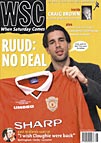 The killing of two Leeds fans in Turkey was a shock to David O'Byrne, one of the first journalists on the scene. Here he describes the reaction in Istanbul
The killing of two Leeds fans in Turkey was a shock to David O'Byrne, one of the first journalists on the scene. Here he describes the reaction in Istanbul
I’m still in shock. I’ve lived in Istanbul for 12 years – for ten years within walking distance of Taksim Square where the two Leeds United supporters were murdered on April 5. And I don’t understand why it happened.
Taksim itself is dull, but surrounded by a labyrinth of narrow back streets crammed with cafés, bars and kebab houses. It’s trendy and wild, but usually remarkably safe.
That evening I was in a bar less than 300 metres from the square. I knew nothing about what had happened until 11pm, about an hour after the stabbings, and then only thanks to a chance encounter with another English journalist. At the nearby hospital we found two English fans: one crying, the other strutting and aggressive. Requests for information were met with an invitation to get lost and an obscene gesture for the Turkish police and TV cameras.
I have since seen earlier TV footage of the same pair, in the same hospital, leering, making obscene gestures and drunkenly querying whether the cameramen had heard of Richard the Lionheart. Sadly this clip, along with footage of the fighting, confirmed in the minds of most Turks that the “English hooligans” had drunkenly provoked a fight in which they had come off worse.
Even so, the media coverage was generally less partisan than in Britain. A couple of the better TV stations ran long discussion programmes analysing the newly discovered phenomenon of Turkish hooliganism. Most of the papers were solid in their condemnation of the violence and respectful of the two who died. Some even edged their reports on the funerals in black.
But others took a deeply unpleasant tone with the mass circulation Star making a truly sick bilingual pun on the number two – two goals, two dead. Two weeks later the smaller Gunes was little better, heralding the departure of the Galatasaray team to Leeds with “It’s as if they’re going to war”. But neither the Turkish press nor the frankly fantastical accounts in Britain go very far to shedding any real light on the night’s events.
Witnesses described a depressingly familiar scenario. About 9.30 – roughly half an hour before the killings – one group of drunk Leeds fans started jostling people on the south side of Taksim Square, and were confronted by a smaller group of unarmed Turks. One witness claims that in the next five minutes she saw other groups of Leeds fans running towards the square, in her words, “as if they knew what was happening and wanted to join in”. With the arrival of a group of armed Galatasaray fans, ineffectual brawling turned into a vicious and ultimately fatal fight.
But why? Was there an incident with a Turkish flag as was claimed? Personally I doubt it. That story only surfaced after the police had taken statements from those arrested, who had an obvious interest in suggesting mitigating factors for their behaviour. The big question, posed by one of the bar owners, is why the police, always a heavy presence in the square, took so long to act. They aren’t normally noted for reticence in cracking heads.
Two Leeds fans I spoke to claimed the stabbings occurred after the police moved in, but also confirmed that the fight involved around 150 Leeds fans against about 40 Turks, a fact the British press chose to ignore.
The whole miserable episode raises so many more questions than answers. I don’t understand why flags are so sacred their (alleged) desecration can incite the murder of innocent men, or why a statue of a dead footballer should attain something of the status of a religious shrine.
Can it be that football is filling the void left by the demise of the nation state or of conventional religion? Do fans see themselves as conquering heroes, or defenders of the one true faith? Is that where Richard comes in? I hope not.
From WSC 160 June 2000. What was happening this month